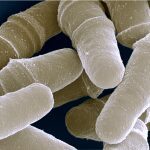Link to Pubmed [PMID] – 28846478
Cell Cycle 2017 Sep;16(18):1643-1653
The nucleolus is a distinct compartment of the nucleus responsible for ribosome biogenesis. Mis-regulation of nucleolar functions and of the cellular translation machinery has been associated with disease, in particular with many types of cancer. Indeed, many tumor suppressors (p53, Rb, PTEN, PICT1, BRCA1) and proto-oncogenes (MYC, NPM) play a direct role in the nucleolus, and interact with the RNA polymerase I transcription machinery and the nucleolar stress response. We have identified Dicer and the RNA interference pathway as having an essential role in the nucleolus of quiescent Schizosaccharomyces pombe cells, distinct from pericentromeric silencing, by controlling RNA polymerase I release. We propose that this novel function is evolutionarily conserved and may contribute to the tumorigenic pre-disposition of DICER1 mutations in mammals.

